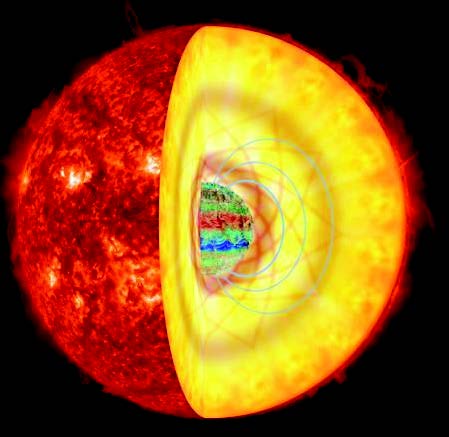 Jim Fuller, Matteo Cantiello and Lars Bildsten. Photo by Bill Wolf.
Jim Fuller, Matteo Cantiello and Lars Bildsten. Photo by Bill Wolf.
Magnetic fields have important consequences in all stages of stellar evolution, from a star’s formation to its demise. Now, for the first time, astrophysicists are able to determine the presence of strong magnetic fields deep inside pulsating giant stars.
A consortium of international researchers, including several from KITP, used asteroseismology — a discipline similar to seismology — to track waves traveling through stars in order to determine their inner properties. Their findings appeared in the journal Science this Fall.
“We can now probe regions of the star that were previously hidden,” said co-lead author Matteo Cantiello, a specialist in stellar astrophysics at KITP. “The technique is analogous to a medical ultrasound, which uses sound waves to image otherwise invisible parts of the human body.”
Cantiello’s curiosity and that of his co-authors was sparked when astrophysicist and KITP participant Dennis Stello of the University of Sydney presented puzzling data from the Kepler satellite, a space telescope that measures stellar brightness variations with very high precision. Cantiello, KITP director Lars Bildsten and Jim Fuller, a postdoctoral fellow at the California Institute of Technology, agreed that this was a mystery worth solving. After much debate, many calculations and the additional involvement of Rafael García, a staff scientist at France’s Commissariat à l’Énergie Atomique, a solution emerged. The data were explained by the presence of strong magnetic fields in the inner regions of these stars.
The puzzling phenomenon was observed in a group of red giants imaged by Kepler. Red giants are stars much older and larger than the sun. Their outer regions are characterized by turbulent motion that excites sound waves, which interact with gravity waves that travel deep into the stellar core. Magnetic fields in the core can hinder the motions produced by the gravity waves.
“Imagine the magnetic field as stiff rubber bands embedded in the stellar gas, which affect the propagation of gravity waves,” Fuller explained. “If the magnetic field is strong enough, the gravity waves become trapped in the star’s core. We call this the magnetic greenhouse effect.”
 This artist’s representation of a red giant star with a strong internal magnetic field shows sound waves propagating in the stellar outer layers, while gravity waves propagate in the inner layers where a magnetic field is present.
This artist’s representation of a red giant star with a strong internal magnetic field shows sound waves propagating in the stellar outer layers, while gravity waves propagate in the inner layers where a magnetic field is present.
Credit: Rafael A. García (SAP CEA), Kyle Augustson (HAO), Jim Fuller (Caltech) & Gabriel Pérez (SMM, IAC). Photo from AIA/SDO
The trapping occurs because the incoming wave is reflected by the magnetic field into waves with a lower degree of symmetry, which are prevented from escaping the core. As a result, stellar surface oscillations have smaller amplitude compared to a similar star without a strong magnetic field.
“We used these observations to put a limit on — or even measure — the internal magnetic fields for these stars,” Cantiello said. “We found that red giants can possess internal magnetic fields nearly a million times stronger than a typical refrigerator magnet.”
“This is exciting as internal magnetic fields play an important role both for the evolution of stars and for the properties of their remnants,” Cantiello added. “For example, some of the most powerful explosions in the universe — long gamma-ray bursts — are associated with the death of some huge stars. These behemoths — 10 or more times more massive than our sun — most likely ended their lives with strong magnetic fields in their cores.”
In a subsequent paper in the journal Nature, the same scientists along with additional colleagues, applied this new technique to the very precise data supplied by Kepler. Analyzing the light curves for about 3,000 stars, the team found that the presence or absence of a magnetic field depends on the star’s mass.
The researchers saw a very clear dichotomy between stars with masses less than 1.1 times that of the sun and those with masses greater than 1.1. Stars close to the size of the sun did not appear to have magnetic fields in their cores, while the opposite was true of stars in the intermediate category — 1.1 to 2 times the mass of the sun — where upward of 50 to 60 percent had strong internal magnetic fields.
“Because intermediate stars are hotter and more luminous, their core is stirred by convection,” Bildsten said. “This magnetic field is created by this ‘boiling’ pattern sequence and stored inside the star as it evolves to become a red giant. Astrophysicists have suggested this previously but it was very speculative; now it seems clear that this is the case.”
- Julie Cohen, UCSB Public Affairs & Communication
KITP Newsletter, Winter 2016
